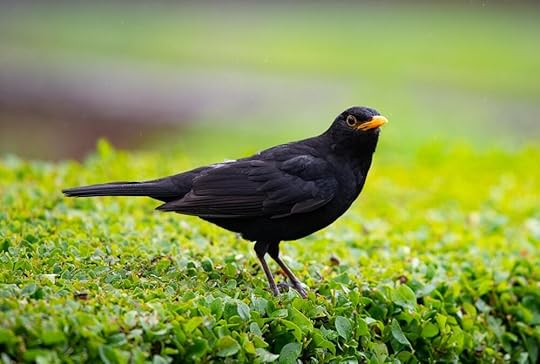Thirteen Ways of Looking at a Blackbird — Wallace Stevens
 Among twenty snowy mountains,The only moving thingWas the eye of the blackbird.III was of three minds,Like a treeIn which there are three blackbirds.IIIThe blackbird whirled in the autumn winds.It was a small part of the pantomime.IVA man and a womanAre one.A man and a woman and a blackbirdAre one.VI do not know which to prefer,The beauty of inflectionsOr the beauty of innuendoes,The blackbird whistlingOr just after.VIIcicles filled the long windowWith barbaric glass.The shadow of the blackbirdCrossed it, to and fro.The moodTraced in the shadowAn indecipherable cause.VIIO thin men of Haddam,Why do you imagine golden birds?Do you not see how the blackbirdWalks around the feetOf the women about you?VIIII know noble accentsAnd lucid, inescapable rhythms;But I know, too,That the blackbird is involvedIn what I know.IXWhen the blackbird flew out of sight,It marked the edgeOf one of many circles.XAt the sight of blackbirdsFlying in a green light,Even the bawds of euphonyWould cry out sharply.XIHe rode over ConnecticutIn a glass coach.Once, a fear pierced him,In that he mistookThe shadow of his equipageFor blackbirds.XIIThe river is moving.The blackbird must be flying.XIIIIt was evening all afternoon.It was snowingAnd it was going to snow.The blackbird satIn the cedar-limbs. THOUGHTS ABOUT THIS POEMAs the title suggests, the poem is about different ways of seeing and perceiving the world—with the blackbird being the specific point of focus. In fact, Stevens himself called this poem a group of “sensations”—fleeting experiences that don’t necessarily have an obvious meaning. (Haddam is a small town in Connecticut, approximately 30 miles south of Stevens’ home in Hartford.) This poem was written by Stevens in 1917. He stated that it was a collection of sensations. “Each miniature creates a world of possibility for the reader, each scenario has a different ‘feel’. The landscape changes, there are subtle movements, there are degrees of involvement determined in part by poetic form.”I present it to you today, as a comment on speed, variety, the inundation of information, words, photos, even sounds. I wonder how future brains will change after the bombardment of information that starts from the moment we are born. Certainly our environments create us in some ways. We see that in adults whose childhoods damaged them irreparably, though sometime intense therapy can heal.Though I studied poetry in college, I had never read this poem. So I bring it to you today for three reasons: how it challenges the reader; the beauty it provides and finally a question that stems from it: in our world of sound, images, fast-moving news, film, music, even how our bodies can be transported within hours to places we have never seen–do you feel settled in one place? Is there something you do to ground yourself? And if you do, does it help?Thanks for reading, Beth (I tried to provide more reading space, but Word Press fought back!)Thanks to: https://owlcation.com/humanities/Analysis-of-Poem-Thirteen-Ways-of-Looking-at-a-Blackbird-by-Wallace-StevensFacebook Twitter LinkedInPinterest
Among twenty snowy mountains,The only moving thingWas the eye of the blackbird.III was of three minds,Like a treeIn which there are three blackbirds.IIIThe blackbird whirled in the autumn winds.It was a small part of the pantomime.IVA man and a womanAre one.A man and a woman and a blackbirdAre one.VI do not know which to prefer,The beauty of inflectionsOr the beauty of innuendoes,The blackbird whistlingOr just after.VIIcicles filled the long windowWith barbaric glass.The shadow of the blackbirdCrossed it, to and fro.The moodTraced in the shadowAn indecipherable cause.VIIO thin men of Haddam,Why do you imagine golden birds?Do you not see how the blackbirdWalks around the feetOf the women about you?VIIII know noble accentsAnd lucid, inescapable rhythms;But I know, too,That the blackbird is involvedIn what I know.IXWhen the blackbird flew out of sight,It marked the edgeOf one of many circles.XAt the sight of blackbirdsFlying in a green light,Even the bawds of euphonyWould cry out sharply.XIHe rode over ConnecticutIn a glass coach.Once, a fear pierced him,In that he mistookThe shadow of his equipageFor blackbirds.XIIThe river is moving.The blackbird must be flying.XIIIIt was evening all afternoon.It was snowingAnd it was going to snow.The blackbird satIn the cedar-limbs. THOUGHTS ABOUT THIS POEMAs the title suggests, the poem is about different ways of seeing and perceiving the world—with the blackbird being the specific point of focus. In fact, Stevens himself called this poem a group of “sensations”—fleeting experiences that don’t necessarily have an obvious meaning. (Haddam is a small town in Connecticut, approximately 30 miles south of Stevens’ home in Hartford.) This poem was written by Stevens in 1917. He stated that it was a collection of sensations. “Each miniature creates a world of possibility for the reader, each scenario has a different ‘feel’. The landscape changes, there are subtle movements, there are degrees of involvement determined in part by poetic form.”I present it to you today, as a comment on speed, variety, the inundation of information, words, photos, even sounds. I wonder how future brains will change after the bombardment of information that starts from the moment we are born. Certainly our environments create us in some ways. We see that in adults whose childhoods damaged them irreparably, though sometime intense therapy can heal.Though I studied poetry in college, I had never read this poem. So I bring it to you today for three reasons: how it challenges the reader; the beauty it provides and finally a question that stems from it: in our world of sound, images, fast-moving news, film, music, even how our bodies can be transported within hours to places we have never seen–do you feel settled in one place? Is there something you do to ground yourself? And if you do, does it help?Thanks for reading, Beth (I tried to provide more reading space, but Word Press fought back!)Thanks to: https://owlcation.com/humanities/Analysis-of-Poem-Thirteen-Ways-of-Looking-at-a-Blackbird-by-Wallace-StevensFacebook Twitter LinkedInPinterest
Published on April 24, 2022 08:00
No comments have been added yet.



